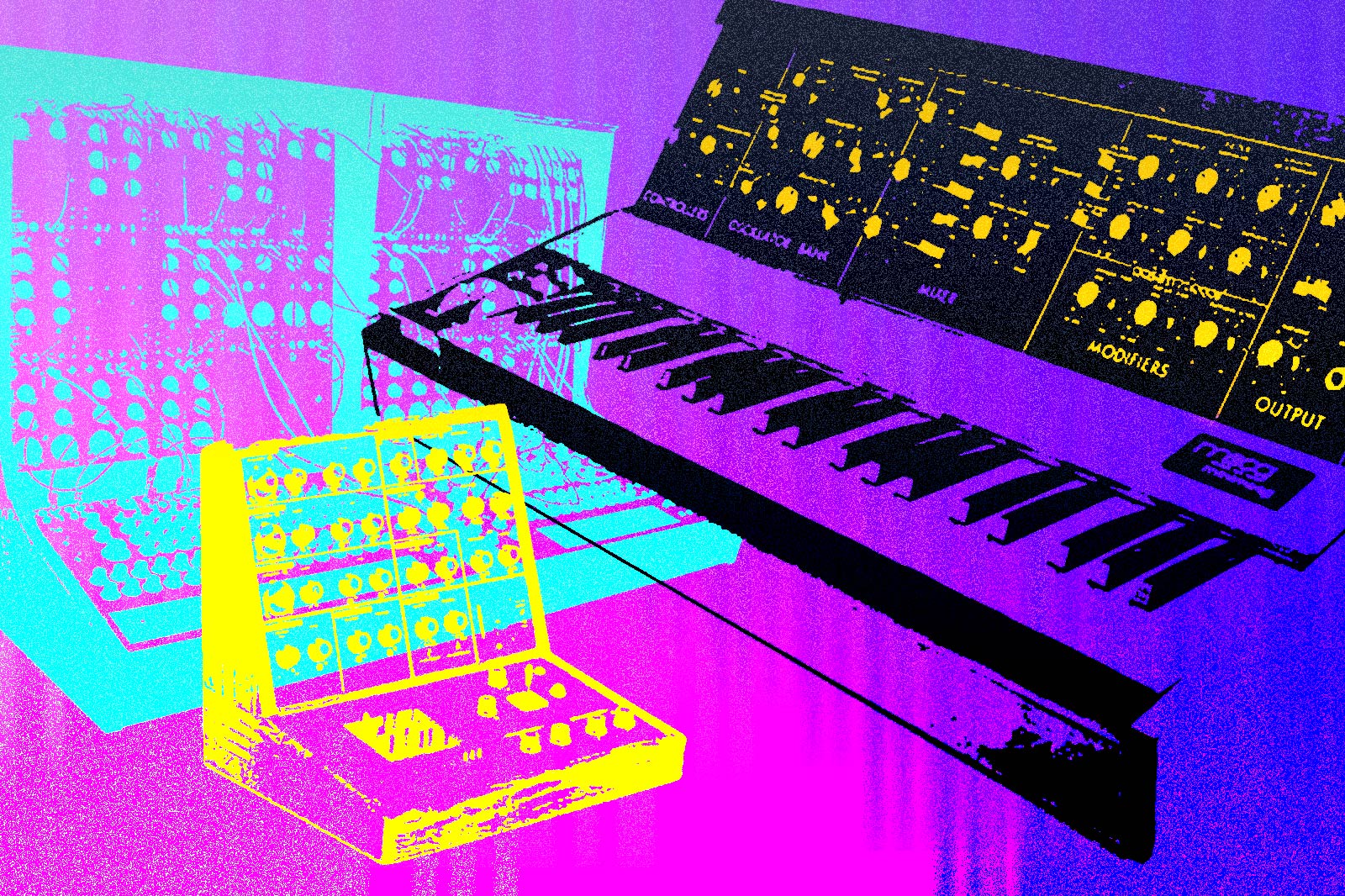This question comes up often—and if you're looking for an answer that satisfies the requirements of a test for your music history class, there's a fairly simple answer. Who invented the synthesizer? Robert Moog and Don Buchla invented the synthesizer, each working on separate coasts of the United States in the 1960s, giving way to two well-known approaches to electronic instrument design.
But...did they really invent the synthesizer? When we look at the history of any invention, we often find that there is an individual, or at the very best, a small group that are credited as the "pioneers" of the field. And while the contributions of some can certainly be more significant than others, this view of history is problematic—as it presents an incomplete and rather distorted narrative. Interestingly, the particular celebrated individual or a group may even be slightly different depending on what culture you happened to be born in, though frequently, "who was first" is still a subject of debate.
While most of human history is increasingly removed from our present lives, inventions such as synthesizers are particularly interesting, as they came into existence so recently. Therefore, we should have a much clearer understanding of the history of the invention. But do we really? There have been numerous articles written on the history of synthesizers, and with this one we hope to offer a somewhat different perspective.
So...Who Invented the Synthesizer?
Presumably, with many of the people who witnessed the birth of this new musical instrument still alive, it would be reasonable to assume that we have a pretty good idea of who created it, but upon a closer examination, considering the structure of the modern world and the intricacies of how information spreads, many questions arise. It is important to point out here that the evolution of synthesizers coincided with the rise of two closely intertwined forces—mass media and advertising. This means that a lot of our knowledge of synthesizers largely depends on who was portrayed in the media over the years as the heroes of innovation (and the level of persistence afforded to such portrayal). This article has no intention to discuss the positive and negative aspects of that relationship, but it is mentioned here to illustrate that the information we get can have a number of biases. A good example of this is the systematic exclusion of female and non-Western pioneers of electronic music in the past. Only in recent years names like Maryanne Amacher, Alireza Mashayekhi, Otto Sidharta, Daphne Oram, Beatriz Ferreyra, and a multitude of others have begun to work their way into the global narrative of electronic music history as we try to restore the balance.
Another important thing to note is that when we think of synthesizers, we often think about particular products rather than an instrument in an abstract sense, which is quite different compared to how we think about a cello or a flute. Of course, synthesizer by nature is a different kind of instrument altogether as it can take any number of shapes—in a way, it is an entire class of instruments (and we seldom ask, for instance, who "invented" brass instruments). The main point here is that by focusing our attention solely on the history of commercially produced synthesizers, it is very possible to overlook inventors whose approach or goals were different or perhaps even those whose commercial products were not as successful.
This is intensified even further with the skewed design of algorithms in contemporary search engines, which are not necessarily concerned with truthfulness of their results—instead, they are concerned with compliance to the input query, factors such as specifics about HTML formatting, page load time, bounce rate, and the overall perceived "authority" of the source. While this does reward user engagement...it does not necessarily reward truthfulness at the source, and as such, bias goes unchecked.
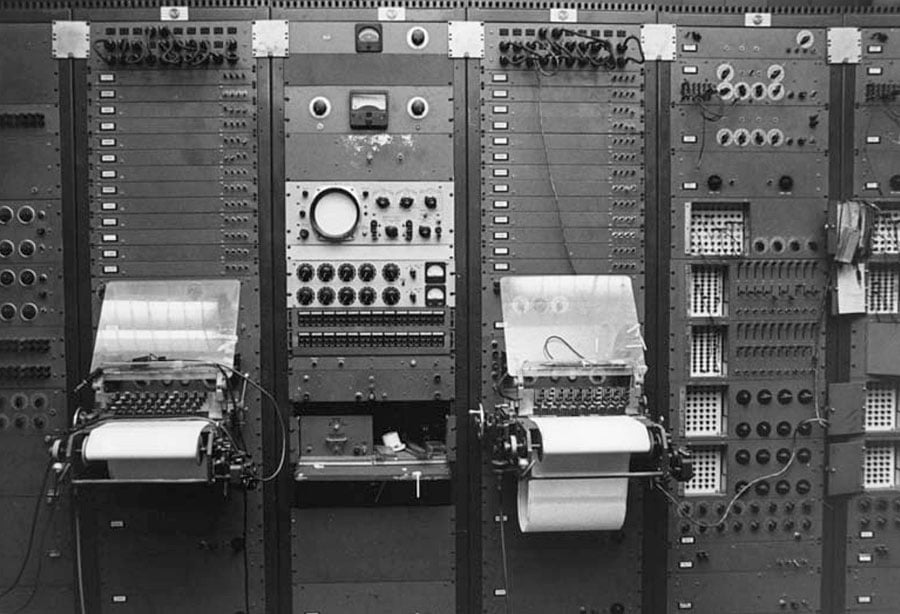
If you submit the simple query "who invented synthesizer" into Google, the first few results (at the time of writing this article) will suggest to you that Robert Moog was the father of synthesizers, or perhaps that RCA Mk I and II (in the image above) were the earliest examples of synths. Of course, we don't have anything against Moog—he was undoubtedly a great thinker, inventor, and entrepreneur, and we certainly love a good ladder filter—and similarly we truly appreciate the contributions of Harry Olson and Herbert Belar (chief designers of the early RCA Synthesizers). However, knowing even one synthesizer preceding them, these results become questionable. Ironically, if you ask Google "what is the best search engine" you'll get a not so humble "Google" in response.
This leads us to suggest a rather different strategy in answering the age-old question, "who invented a synthesizer?". Perhaps it wasn't Bob Moog, Don Buchla, Peter Zinovieff, Herbert Belar, Harry Olson or even Leon Theremin or Thaddeus Cahill who single-handedly invented a new instrument, but instead, the synthesizer happened as an inevitable result of countless discoveries by a multitude of creative minds fascinated by the potential of exponentially improving technology over centuries, and each inventor offers a unique voice in that ongoing dialog with technology. Again, this is by no means an attempt to diminish the value of any of the compelling (and crucial) work of the aforementioned individuals, but rather to put it in relation to one another, as well as countless other rarely talked about or even unmentioned altogether. Instead, it is a proposition to view the history of electronic music and synthesizers not from the perspective of competition, but from the point of direct or indirect collaborations.
In the photo below is Daphne Oram drawing timbres on the Oramics Machine (Image courtesy: Fred Wood/Daphne Oram
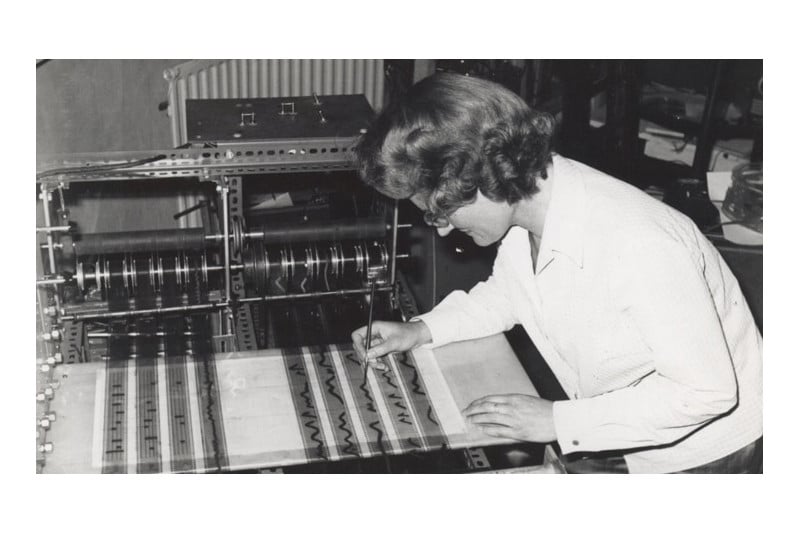
This is not a particularly new idea either, and this view was even expressed almost half a century ago by one of the pioneers herself. In her 1972 publication An Individual Note: of Music, Sound and Electronics, Daphne Oram writes:
"Do not let us fall into the trap of trying to name one man as the 'inventor' of electronic music. As with most inventions, we shall find that as certain changes in circumstances occurred—as certain new facilities became available—many minds were, almost simultaneously, excited into visualizing far reaching possibilities. New developments are rarely, if ever, the complete and singular achievement of one mind. Yet, when we speak of an invention, we seem to delight in persistently naming one man as the originator... I wonder why we want so much to see one man as the hero of the occasion."
Thus it appears that rather than trying to chase that ineffable sole inventor of synthesizer, and hoping to find a solution to the seemingly impossible, and perhaps even irrelevant question of "who was first," it would be much more fruitful to explore the instrument in its multifaceted nature, and attempt to connect some dots that led to it becoming a defining musical instrument of the space age.
The Proto-Synthesizer
Before "sound synthesizer" was even a valid combination of words, many of the ideas associated with the instrument were explored in the realms of acoustic and mechanical instruments. The history of music is the history of music technology, and it is fair to say that every culture played an important role in the evolution of that technology at different periods of time. The modern day guitar wouldn't exist without the ancient chordophones like the European lute and Arabic oud. The same goes for the synthesizer, as there were countless historical developments spanning across cultures that led to the emergence of this instrument. In the Signal article on sequencers we traced the origin of automated musical devices back to the 9th century—the 'water organ' invented by the Banu Musa brothers. This gives us a good perspective of how long we have been on a path to create automated musical instruments. The rise of player pianos and orchestrions in the early 20th century is yet another demonstration of the evolution of that thought.

And if we wish to pinpoint the earliest attempts at sound synthesis in the widest sense of what it means, perhaps there is no better example than the pipe organ, with its earliest forms dating as far back as 3rd century BC. Of course, an organ isn't exactly a synthesizer in the traditional sense, as in our contemporary discourse a synthesizer by default is an electronic musical instrument. However, in concept, a pipe organ is a sort of acoustic additive proto-synthesizer, where a complex tone is generated by a combination of individual differently-sized pipes and pressurized air passing through them. Thus it is no wonder, why the design of one of the earliest electronic musical instruments created—Telharmonium (1897)—was largely based on a similar principle, albeit in place of large organ pipes it utilized electromagnetic turbine-like tone generators.
So What Is A Synthesizer, Anyway?
Close your eyes, and try to imagine a synthesizer...any synthesizer. What does it look like? While the image that each of us sees in our minds will differ to a varied extent, depending on our backgrounds and preferences, it is fairly likely that the shape of the instrument you imagine has a keyboard, perhaps a couple of wheels next to it, and certainly some knobs. Why is that? Do any of these things really define what a synthesizer is, or are they something that got attached to the idea of an instrument over the years?
If you try to look up a dictionary definition of a synthesizer you'll find a few results which will be somewhat different from one another. For example, at the time of writing this article, the Merriam-Webster definition emphasizes that a synthesizer is "a usually computerized electronic apparatus" while the Oxford dictionary states that the instrument is "typically operated by a keyboard". While both of those things can certainly be true, we know that they do not necessarily represent the essence of the instrument. In the broadest sense a contemporary description of the instrument can be established as a hardware or software musical instrument that allows for design, generation and control of sound through electronic means.
The means of controlling a synthesizer can take a great variety of forms: from the common keyboards, to sequencers and modulators, to mouth-controlled interfaces, to audio signals, to all sorts of sensors—literally any action or circumstance that can be measured has the potential to become a synthesizer controller. The reason that keyboard interfaces became so popular is because, in the early days of synthesis, they appealed to a large number of musicians as an easy gateway into the world of new sounds without having to learn how to play the new instrument from scratch. Some inventors saw a great commercial potential in this, while others chose a different route—playing directly into the previously stated notion that our perception of the development of the synthesizer as an instrument is directly related to some inventors' commercial success.
Parallel Histories
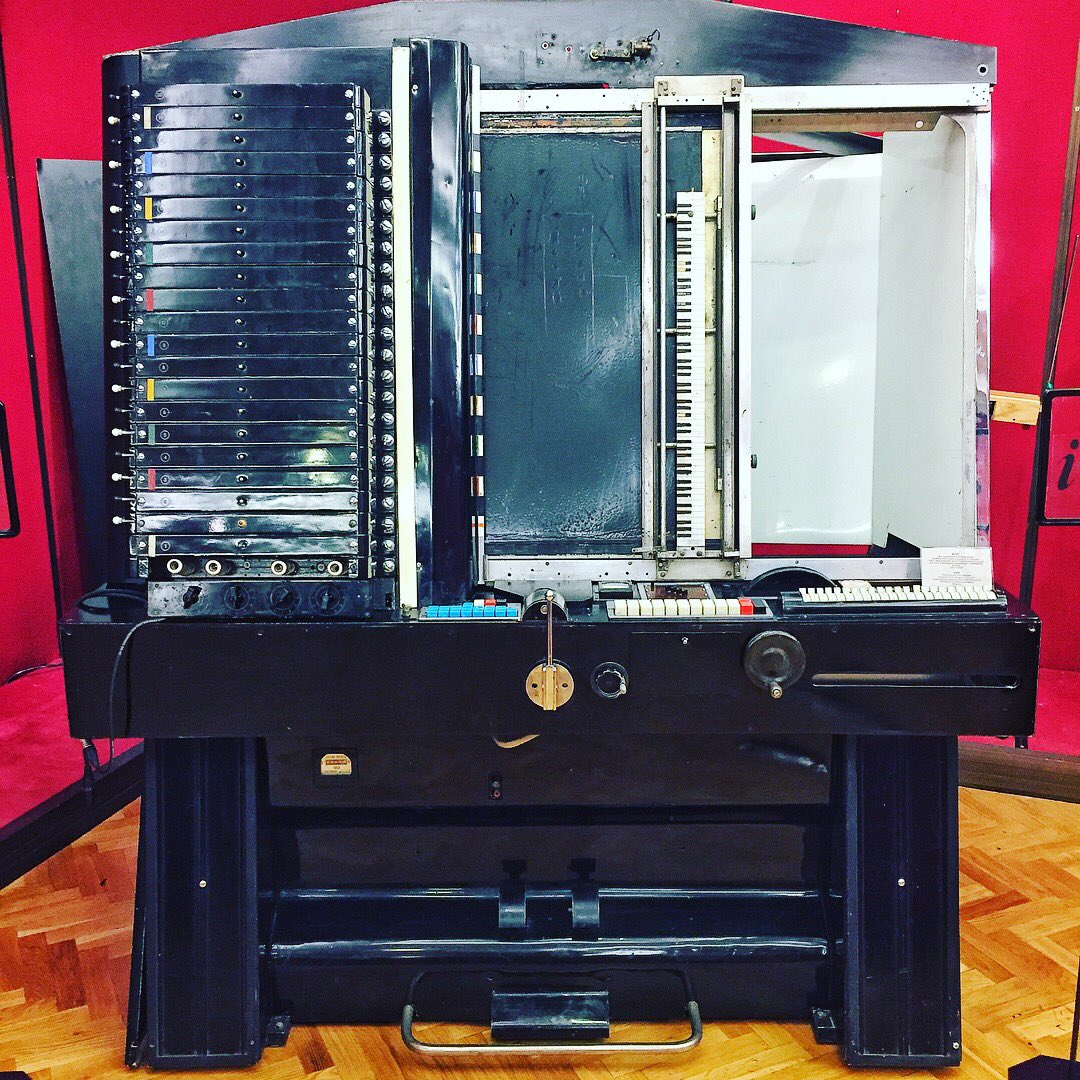 ANS Synthesizer (Image courtesy: Richard Devine)
ANS Synthesizer (Image courtesy: Richard Devine)
Whereas we can be inclined to see history as a sort of monolithic whole, if you look closely it quickly becomes obvious that it is stitched together with multitude of threads that sometimes cross, other times diverge, and occasionally run parallel to one another. This is often a feeling that I personally get when trying to navigate the past of synthesizers, and electronic music. Opening one door inevitably leads to a seemingly endless hallway with many more. For example it is quite often said that the RCA Mark I and Mark II were the first synthesizers, and that is all good and well...but then you turn around and find out about the Coupleux-Givelet Organ invented fifteen years earlier implementing a very similar punched paper method and vacuum tube oscillators.
It also becomes apparent that different inventors had different goals for making a synthesizer, and without claiming to unveil or even completely understand what various synth makers were after, we can see in particular two distinct paths of synthesizer development. Let's call them pragmatic and radical.
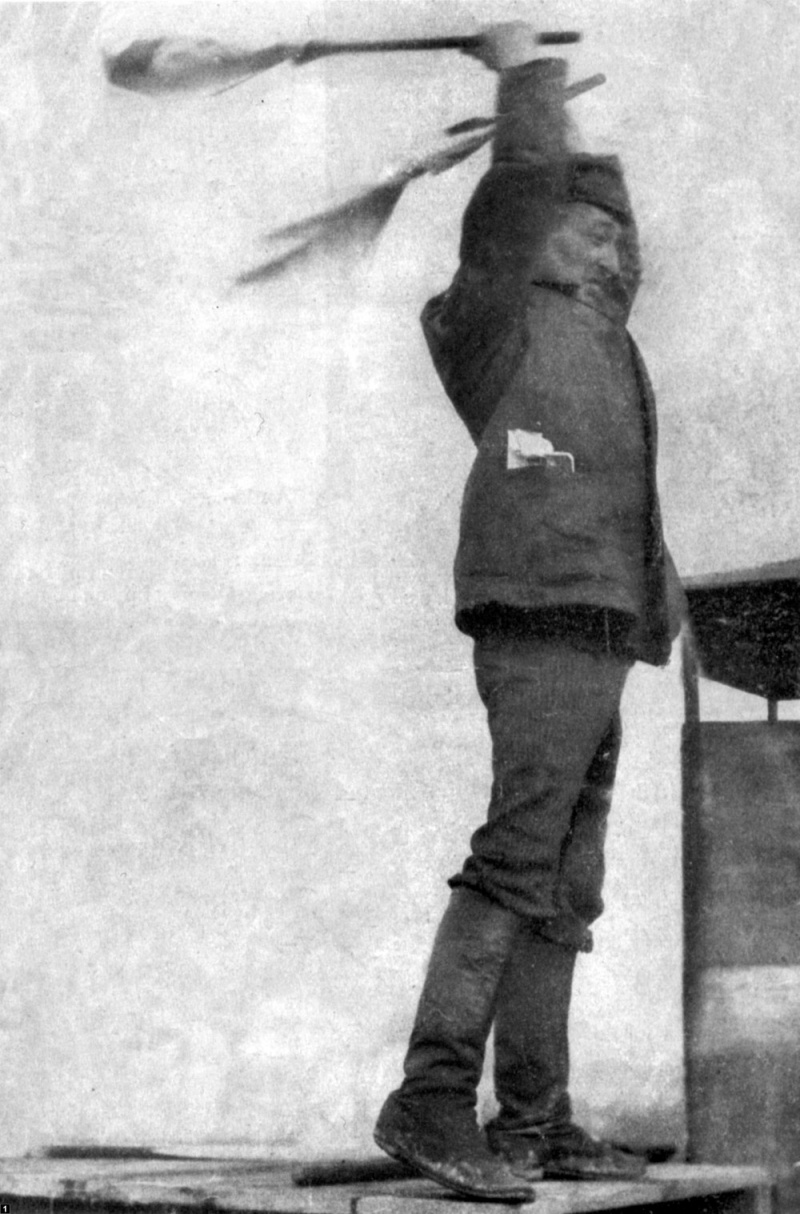 Avraamov conducting "Symphony of Sirens"
Avraamov conducting "Symphony of Sirens"
At the turn of the 20th century, many things were happening in the world—and many corners of the world were bubbling with a revolutionary spirit. In retrospect, this time appears to have been a moment where archaic systems were failing, and many people from different parts of the world were ready for radical changes. Important signifiers of that strive for the new within the realms of culture and music can be observed in Luigi Russolo's "Art of Noise" manifesto published in 1913, and Arseniy Avraamov's "Symphony of Sirens" 1922 performance among others. Analyzing the mood and ideas expressed in artworks, compositions, and new proposed systems of the period, it is evident that many things of the past were seen as oppressive—including common European musical instruments such as the piano and 12-tone temperament in general. Avraamov famously submitted a proposal to the Commissar of Public Enlightenment, Anatoly Lunacharsky for a project that entailed burning of all pianos in Russia. While that proposal wasn't exactly approved, on a smaller scale, that idea would be realized decades later with an aptly titled piece "Piano Burning" (1968) by the New Zealand composer Annea Lockwood. This makes it relatively clear why many early instruments developed in Soviet Union had a radically new approach to sound synthesis—drawing waveforms on film couldn't be further removed from playing a J.S. Bach sonata on a traditional classical instrument.
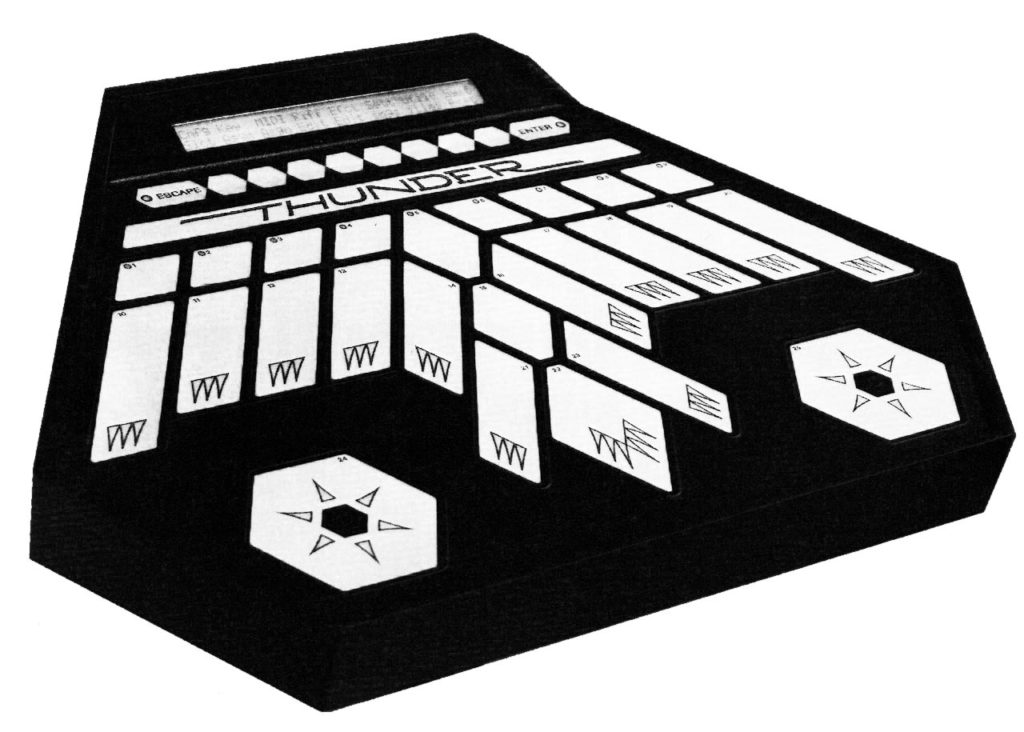 Iconic Buchla Thunder controller
Iconic Buchla Thunder controller
Although the early 20th century spared the US of revolution in the political arena, the second half of it certainly had major social changes and shifts in perspectives. Additionally, somewhat detached from classic European traditions, the country overall appeared to be much more receptive to fresh ideas—the New World was ready for new music. This clearly manifested in the approach taken by Donald Buchla beginning in the 1960s, as he intentionally tried to develop an instrument that would be an open framework for new musical expression. Omitting the keyboard as a controller was a rather strategic move to accomplish that vision (though, of course, many of his later instruments did employ black-and-white keyboards and derivative touchplate-based designs). This direction was developed in collaboration with a group of young composers like Morton Subbotnick and Ramon Sender, two founders (along with Pauline Oliveros) of the San Francisco Tape Music Center, a place for research and experimentation with new sounds and forms of music.
However, not everyone was ready to completely abandon the rich musical past, and some approaches to designing synthesizers were driven at least in part by practical solutions to certain musical problems. For example, one common obstacle among composers altogether was the gap between the process of composition and hearing the result. The complexity of logistics and costs involved in hiring musicians and rehearsing before the music can finally be performed was another. The synthesizer promised to solve these problems through immediacy of response and automation of arrangements. As a piece of historical anecdote—supposedly Vladimir Ussachevsky referred to the potential of new instruments for eliminating the need of unionized orchestras and significantly reducing the cost of music production and recording as key points to get a grant from the Rockefeller Foundation to build the RCA Synthesizer.
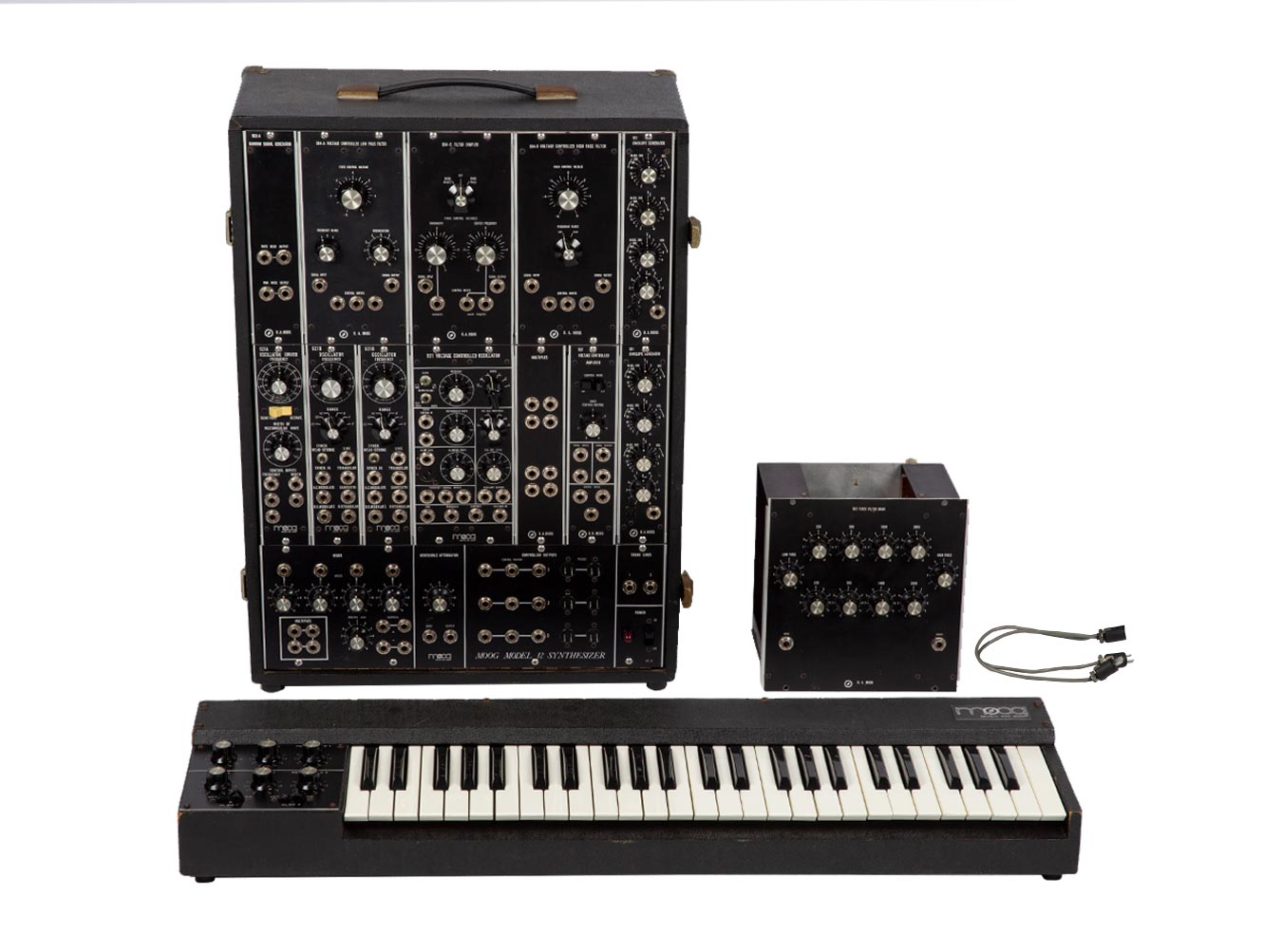 Moog Model-12 System
Moog Model-12 System
As mentioned earlier, the introduction of the keyboard as a principal synthesizer controller was also a clever move from Moog, which in turn attracted many professional musicians to the new instrument—it was met with an overwhelmingly positive response from many. As a consequence, the synthesizer was set on a path to eventually behave sonically fairly similarly to the piano instead of introducing a completely alien paradigm, and in some ways, the synthesizer has succeeded the piano as a tool for modern music-making—these days, it is considerably more common to find a synthesizer in a studio than an actual acoustic piano.
It is also interesting to note here is that while avant-garde and experimental composers/musicians were occupied with developing drastically new sonic and musical languages, the followers of a pragmatic approach to synthesis instead aimed at recreating acoustic sounds electronically, hence patch examples and later presets in digitally controlled synths commonly were named after the acoustic instruments that they represented like "violin", "cello", "piano", "clarinet", et al—hence solidifying the idea that synthesizer was in essence an "orchestra in a box".
Artists Matter
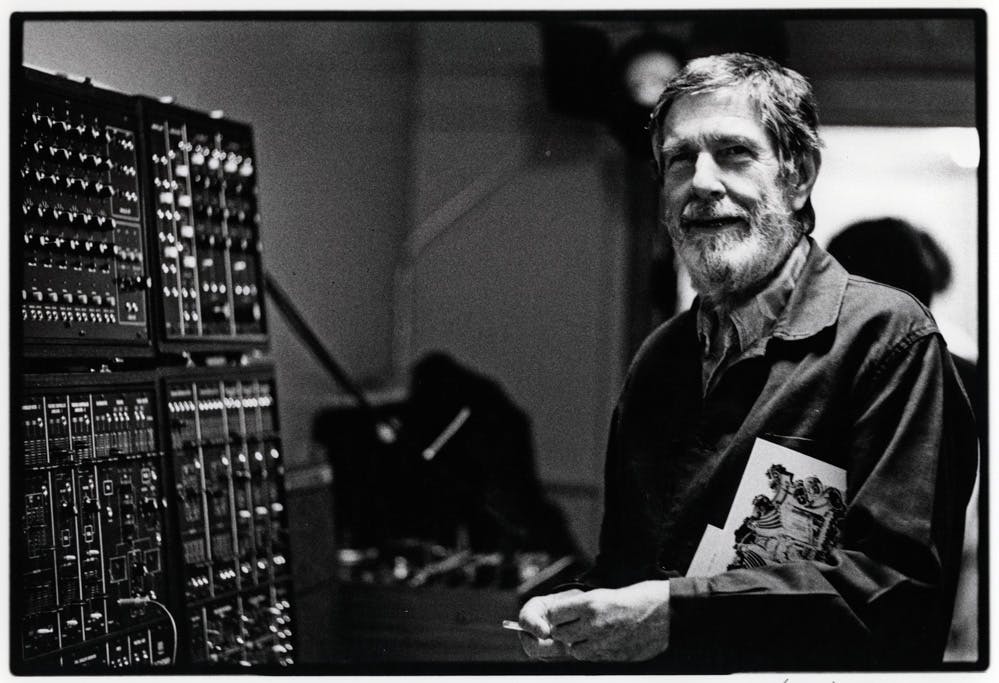 John Cage also played a major role in introducing chance-based operations to the process of composition. These days various stochastic methods are increasingly wide-spread in the processes of creating and performing electronic music. (Image courtesy: Corinto Marianelli)
John Cage also played a major role in introducing chance-based operations to the process of composition. These days various stochastic methods are increasingly wide-spread in the processes of creating and performing electronic music. (Image courtesy: Corinto Marianelli)
Historically, we tend to divide the roles of engineers, inventors, musicians, and composers. That division conforms to an archaic hierarchical structure where the "thinkers" (composers, inventors) were placed higher than "laborers" (musicians, engineers), and as such the activities of the former were valued more within a given culture. However, this notion has been continuously challenged throughout the 20th and 21st centuries, with roles becoming more fluid and the processes unfolding as equally interdependent. A number of things affected this change, and while it is well beyond the scope of this article to provide a full analysis of what caused the shift in the hierarchy of the institution of music, there are a couple of things worth mentioning because both have direct relationship to the evolution of music technology.
Up until the 20th century, the way people experienced music required very much a physical presence of both the performer and the listener, and sharing of music pretty much meant sharing notation. In other words, one had to either play an instrument themselves or hire a musician to enjoy music. The new age welcomed us with fascinating new technology—recorded sound, which meant that now anyone could enjoy a captured piece of music anytime they desired. The aspiring composers of the time quickly realized that recorded sound was not only a great medium for listening to music, but that it could also become the source for composing music with, and so tape music (and its various subgenres, including Musique Concrete and Elektronische Musik) was born. This was a major moment as composers started to directly interact and perform with tape machines as an instrument—John Cage's "Imaginary Landscape No. 1" (1939) is one of the early examples.
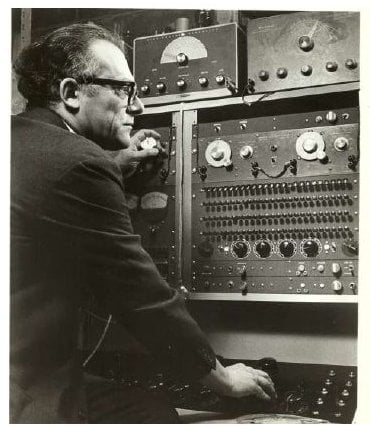 Vladimir Ussachevsky
Vladimir Ussachevsky
Getting a taste of what technology could bring to the development of new music, the composers who had striven to get as far away as possible from the past were quick to adapt any potentially usable bit of electronics to the process of music making. Soon, tape recorders joined sine wave oscillators, filters, and function generators, forming an assemblage of tools that could be seen as a prototypical synthesizer. From this angle, the role of composer-musicians in the creation of the synthesizer becomes evident. In fact, there are many examples of direct relationships between historic synthesizer inventors, and musicians/composers. The aforementioned RCA Mark II developed at the Columbia-Princeton Electronic Music Center was largely co-designed through consultation with the composer Vladimir Ussachevsky. Robert Moog was greatly influenced by composer and collaborator Herb Deutsch, inventor Harald Bode, and composer-inventor Raymond Scott, and it is difficult to imagine a history of the company without Wendy Carlos's Switched On Bach recording.
The same thing can be said about Morton Subotnick's Silver Apples Of The Moon, and Buchla's 100 system. Also, according to the conversation between Thomas Ankersmit and Serge Tcherepnin published recently as part of release of Ankersmit's Perceptual Geography, early Serge circuits were often created in response to the creative needs of composer Maryanne Amacher. He also often built custom electronics for other composers experimenting with electronic sound at the time, including Charlemagne Palestine. And all of that was before the Serge Modular Synthesizer became a reality.
In the photo below are members, and founders of San Francisco Tape Music Center: Bill Maginnis, Tony Martin, Ramon Sender, Mort Subotnick, and Pauline Oliveros. (Image courtesy: Center for Contemporary Music Archive)
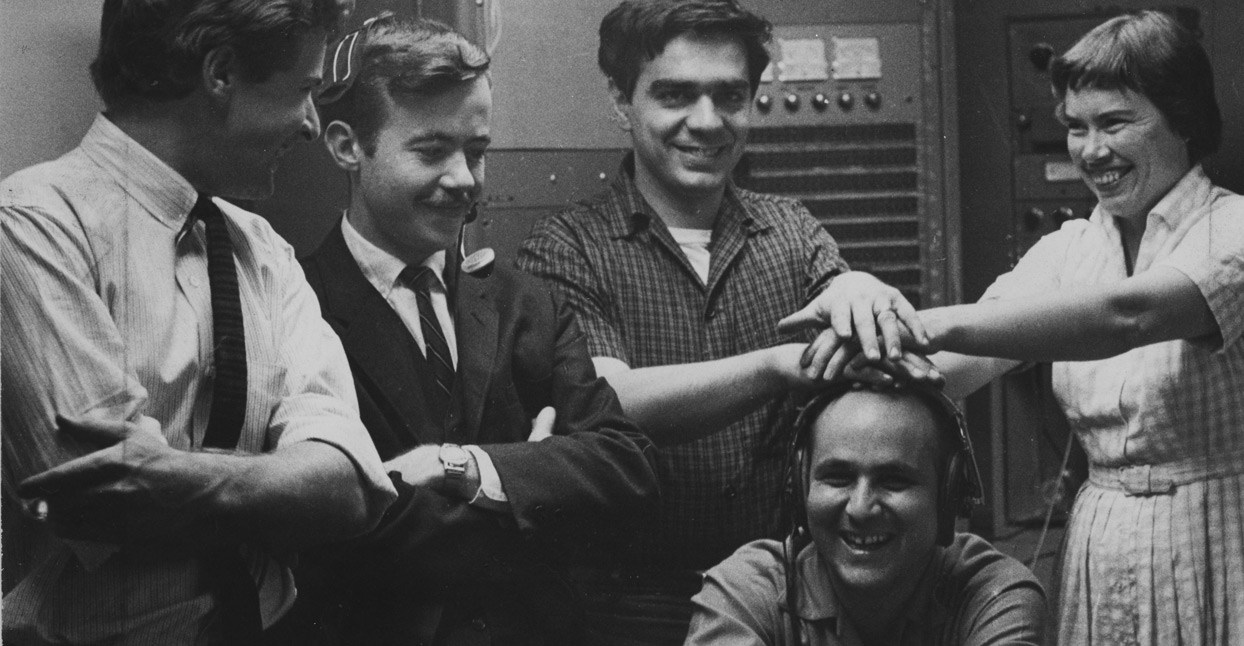
It is also important to point out that different artistic practices in the 20th century experienced a certain level of convergence or overlap. Visual artists were interested in sound as a medium, and musicians delved into visual arts. Luigi Russolo, mentioned earlier in this article, originally was a painter, yet had a major influence on new music. The Fluxus movement that emerged in the late 1950s was truly interdisciplinary, and commonly blurred the lines between visual and sonic arts. As such, the influence on synthesizer development not only can be attributed to musicians, and composers, but to the expanding field of arts in general.
With synthesizers, tape machines, and later computers at their disposal, composers could entirely abandon writing music for orchestras (if desired) and generate sound, control its parameters, perform, and record entirely by themselves. And not only were new instruments explored in the realms of academic music, but they quickly were immersed in pop culture, and certainly acts like Emerson, Lake & Palmer, The Doors, Frank Zappa, and countless others influenced the position of synthesizer in culture.
Eurorack—A Melting Pot of Synthesis

When Dieter Doepfer unveiled the A-100 system in the mid-1990s, it was labeled "Eurorack"—as the modules were housed in the industrial "Euro" card frame. Prior to the Doepfer system, a few modular manufactures had already experimented with Euro frames in late 1970s, namely Elektor, BME, and Synton, albeit they were all out of production by the early 1990s. Thus Doepfer A-100 systems offered a uniquely affordable and compact modular synthesizer format.
At that time, when many musicians were spearheaded towards computer-based workflows, Doepfer's analog patchable synthesizer systems were mostly used by a relatively small group of enthusiasts, far from being a mainstream tool for music making. Little did Dieter (or anyone) know that fifteen years later, his modest innovation would ignite a whole new generation of synthesizer manufacturers across the world, as well as an overwhelming demand from the global community of electronic music makers. But here we are, and at an increasing speed Eurorack format systems of varied sizes are finding their ways into every imaginable studio: from minimal bedroom desktop setups to professional multi room recording/production environments.
What is even more interesting is that whereas dedicated Buchla, Moog, Hordjik, Serge, or any other singular modular frameworks are based on a particular set of synthesis principles in line with the inventor's goals and philosophies, Eurorack metamorphosed into a free-for-all land allowing for a combination of every kind of synthesis, design, and aesthetics. In a single system one can explore analog and digital FM synthesis, wavetable and physical modeling, sampling and granular techniques, one can go East or West, or try experimental techniques like no input mixing—you name it. In that way, modern synthesis is less and less about a lone inventor's singular vision, and more about a synthesis of passions and inspirations from a collective community. In many ways, this format embraces the truth that no one person is responsible for the whole of what we know a synthesizer to be.
It is quite amazing to live in a time where so many approaches and tools for creating music are available, existing simultaneously, even within the same studio or a case. Moreover, the line that separated experimental or avant-garde traditions and mainstream approaches becomes ever more blurry and insignificant. This is a huge development, as it makes the field of sound synthesis more open and inclusive. And although different Eurorack manufacturers certainly have to compete with each other on some level, there is still an element of collaboration and community that can be felt. The designs of the modules are as inspired by earlier developments in electronic music as they aim to offer radically new solutions.
Bringing back the "multiple threads" analogy, it feels suitable to point out that the history of synthesis is still in process, and now all of us are part of it too. It perhaps is not so critical to find out who was first, but it is interesting to consider how we are moving forward. The future of electronic sound and music-making is certainly exciting.

